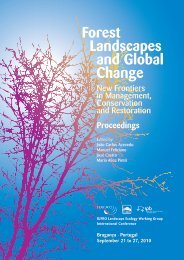Programa e Resumos - I Congresso Ibérico de Ciência do Solo 2004
Programa e Resumos - I Congresso Ibérico de Ciência do Solo 2004
Programa e Resumos - I Congresso Ibérico de Ciência do Solo 2004
Create successful ePaper yourself
Turn your PDF publications into a flip-book with our unique Google optimized e-Paper software.
I <strong>Congresso</strong> Ibérico da Ciência <strong>do</strong> <strong>Solo</strong> – 15 a 18 <strong>de</strong> Junho <strong>de</strong> <strong>2004</strong>, Bragança, Portugal<br />
Heavy metals soil <strong>de</strong>gradation in an area affected by mining wastes of<br />
Murcia (Southeastern Spain)<br />
Joaquin A. Hernán<strong>de</strong>z Bastida, Mª Teresa Fernán<strong>de</strong>z Tapia, Arman<strong>do</strong> Ortuño Castellano<br />
& Francisco Garcia-Villalba Hernán<strong>de</strong>z<br />
1 University of Murcia, Dpt. of Agricultural Chemistry, Geology and Pe<strong>do</strong>logy, Campus<br />
Espinar<strong>do</strong>, 30100 Espinar<strong>do</strong>, Murcia, Spain. Phone: 34- 968 - 367450 – Fax: 34- 968 - 364148<br />
E-mail: hbastida@um.es<br />
Summary<br />
Communication: Poster<br />
The mining wastes are a very important source of environmental contamination, mainly<br />
by heavy metals anywhere they are located. Several areas of Murcia (SE Spain) have<br />
been mining along 2500 years nearly for various metals (silver, lead, zinc, copper, iron,<br />
etc.). The wastes of this activity are accumulated in a lot of silt ponds distributed on<br />
several places. These acid mine spoils present high amounts of heavy metals most of<br />
them are persistent in soil or have been transported by different watercourses to adjacent<br />
places causing a strong environmental <strong>de</strong>gradation. To know the most important soil<br />
characteristics of this area and subsequently to establish the contamination level by<br />
heavy metals and their availability is the aim of present paper.<br />
The studied zone, with an area of about 20 km 2 , is located between Los Urrutias and<br />
Los Nietos villages, very close to Mar Menor (Murcia, SE Spain) and shows an arid<br />
climate with a strong water <strong>de</strong>ficit along the year; the average temperature is about 18ºC<br />
and the rainfall is never higher than 300 mm. According to Alías et al. (1999) the main<br />
soils are Haplic Calcisols, Calcic Luvisols, Calcaric Arenosols and Gleyic <strong>Solo</strong>ntchaks<br />
(FAO-ISRIC-ISSS, 1998). Twenty-one sampling points from the arable layer (0-30 cm)<br />
were taken according to a regular sampling grid of 1 km 2 , besi<strong>de</strong>s a soil profile of<br />
Gleyic <strong>Solo</strong>ntchak. Van Rieuwjk analysis methods (1995) are used to <strong>de</strong>termine soil<br />
properties. The total metal content was <strong>de</strong>termined on acid microwave digestions while<br />
DTPA-extractable metals were <strong>de</strong>termined on a<strong>de</strong>quate soil extracts (Lindsay and<br />
Norvell, 1969), by Atomic Absorption Spectrometry using electrothermal (ETAAS) or<br />
flame atomization (FAAS).<br />
The results show for these samples, in a general way, a low organic carbon content (1-<br />
18 g kg -1 ). There is a wi<strong>de</strong> pH differences (5.5-8,2) because of the oxidation of<br />
sulphi<strong>de</strong>s provokes a strong pH <strong>de</strong>creasing in some points. Variable amounts of CaCO 3<br />
(40-250 g kg -1 ) appear in the samples with alkaline pH values. Most of the samples have<br />
high electrolytic conductivity (2-130 dS m -1 ) in the saturation extract. On the other hand<br />
these the total content of heavy metals present in these soils are in a wi<strong>de</strong> rank of<br />
values: Cr (25-100 µg g -1 ), Cu (15-300 µg g -1 ), Mn (600-7000 µg g -1 ), Ni (20-40 µg g -1 ),<br />
Pb (500-20000 µg g -1 ) and Zn (500–11000 µg g -1 ). However the DTPA-extractable<br />
metal contents are much lower and within levels consi<strong>de</strong>red non-toxic except in those<br />
zones with acid pH values that show a more high content. Therefore it is necessary to<br />
control pH values in those points so that these metals are kept in a low availability for<br />
the crops and, consequently they <strong>do</strong> not cause a toxic effect.<br />
– 102 –
















